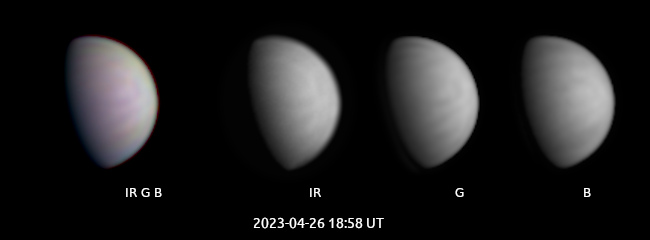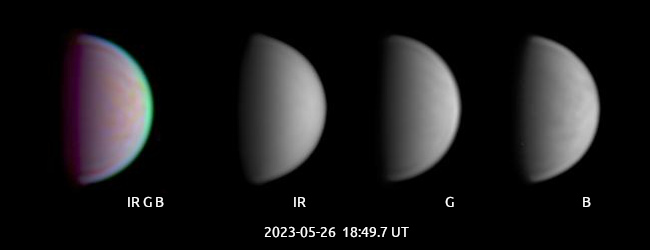



VenusVenus usually reveals her secrects only when recording with bandpass filters at the ends of the visual spectrum, namely in UV and IR. But occasionally, even in th epurely visible G channel some structures can be seen. When the data permit it, IR G B / IR G UV / IR / UV falsescolor images can be used to combine all info into one imageUV recordings with refracting scopes are difficult, because glass & esp. the coating blocks a great portion of UV radiation. Thanks to Venus' very high brightness, the small amount which comes through suffices for a recording, at least when conditions are good. A workaround exists in form of a special filter combination (Baader DarkBlue & Wratten #47) which generates a tramsmission peak at ~ 415nm. The UV features appear with lower contrast, but overall image brighness is higher, which outweighs the former effect, espcially in cases with only average or below average seeing. |
2023
Generally, the IR (lower regions) and UV (higher regions) appearences of the Venus atmosphere differ singificantly. In April 2024, I had the exceptional chance of recording detail in all three channels IR, G and (dark)B, which showed a great degree of correspondance. |

More common case of almost no details in IR (at least not resovable with my equipment), but stronger pattenrs in UV. |

A longer phase with predominantly good weather brought several observation opportunities in May 2022. Of course, seeing was not always good. What can be seen in the sequence is the high volatility of the UV cloud patterns. This makes it difficult to recognize the ~4 day retrograde rotation period of the Venus atmosphere. IR images are more suitable for this purpose. |
2020
In April 2020 I did my first experiments with UV recordings. I remember that month very well because there was an exceptionally long period of almost daily clear sky, during the time of the virus panic and lockdown . So plenty of time and opportunity for observing. But focusing was merely a question of luck, and it was always a surprise some hours (or a day) later after postprocessing. Did I catch something? Or not? In the end this experience led to the idea of the ImageInfo plugin, which was a predecessor for the actual PEAAnuts plugin. Venus illumination fraction was already below 50% at start, and decreased noticably in course of time. The rather strong processing makes the crescent appear even smaller. So always only a small fraction of cloud patterns is depicted, in the striking views, if details are present at all. Comparing these fractions is of course more difficult than comparing images showing a greater portion of the atmposphere. Still, in some image pairs a vague hint for the 4 day rotation period might be recognizable. |
| <-- Back to Space Home | ||

|
||